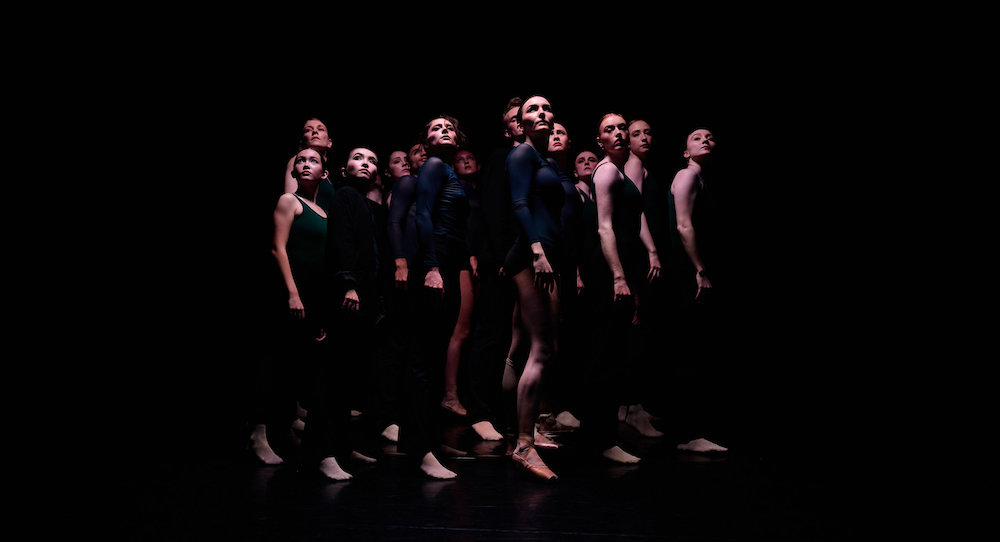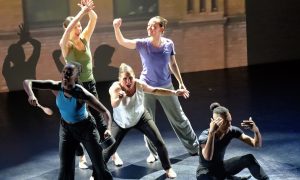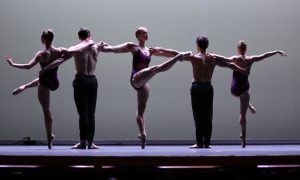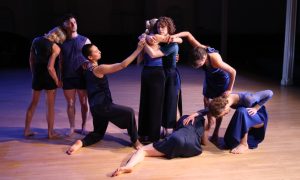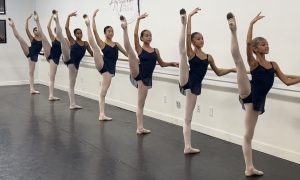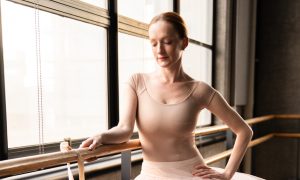Festival Ballet Providence’s Black Box Theater, Providence, RI.
February 19, 2023.
Standing center stage in Festival Ballet Providence (FBP)’s intimate blackbox space, Director Kathleen Breen Combes described the concept of this program – and I could practically feel my face light up. I don’t know if I’ve felt so intrigued, and plain excited, to experience dance art to come.
Breen Combes tasked choreographers with creating works in the theme of 1978 – the year of the company’s founding. And those choreographers came from the company’s very ranks: from first-year apprentices to dancers who’ve been in that number for many years. The works within this theme were as varied and wonderfully original as one could hope; each dancer walked out on a different branch from the support of that theme’s strong trunk.
From concept to structure to movement vocabulary, these young dancemakers inspired hope for this company’s future – and beyond that, in that of this art form – even within a theme pointing to its storied past. Rooting in the past, reaching to an even better future: this program illustrated the indispensibility of both.
Eau d’Effervescence, from FBP Company Dancer Heather Nichols, set the precedent of thinking way outside of the box when it came to connecting concept with the overall program’s theme. Bubbly, bright, sweet: an ode to effervescence indeed. In her introduction, Nichols noted an influence of a Monet waterlily painting – leading to, in closer connection with theme, a 1970s rainbow-of-neons aesthetic (costumes in bright yellows to greens to purples).
The movement aesthetic, for its part, was classical with clean jazzy flourishes. Nichols also updated classics such as “zig-zag” formation (dancers traveling and leaping diagonally, in turn, to create a zig-zagging path of energy across the stage): peppering the new into a dish of the old.
Similarly, the piece offered a lush variety of movement vocabulary while also cycling back to familiar vocabulary favorites within the piece.
Revisiting what could still be found in the established, gazing into the potentiality of the new: the piece cleverly investigated it all. The stage picture also remained visually definitive, not something necessarily easy to maintain in an intimate space such as this black box. Speaking of structure, a small group led into a larger one: vivacious and riveting. That melted into a softer pas de deux. All of these parts felt like snapshots of life in this bubblegum bright world of the past and present. It left me feeling just as bubbly and bright, from the inside out.
Our Perspective, from FBP Trainee Adele Walden, took us into quite a different atmosphere: somber yet resolute, grave yet hopeful. Walden explained a focus on women from all different walks of life, coming together to help each other rise above the obstacles placed before them. As such, duality felt intrinsic to the work. Movement vocabulary offered both pedestrian and virtuosic components. Gesture was both spare and beautifully layered. The stage picture, through various changing formations, remained both full yet visually clear (just as in Eau d’Effervescence).
Why this concept in connection with the year 1978? The largest march for women’s rights took place on July 9th, 1978. With matching costumes in red and white and choral-inspired music (from Ensemble Pirin // Vitamin String Quartet // Warsaw Village Band), my mind went to a world like that of The Handmaid’s Tale: conformist, designed to shrink the available window of women’s experiences, what is desirable determined by another and not by the self. At the same time, these women would not take lying down that narrowing of their potential experiences.
About halfway through the work, just when I felt like an atmospheric shift might be effective, a more assertive feel arose. The music rose in speed and intensity, and the movement to match. United in common purpose, the dancers moved in ferocious unison: projecting resolve and determination. Toward the end of the work, re-emergence of movement vocabulary from earlier in the work brought my mind to cycles and circularity. The age-old task of women rising above continuous constraints, constraints of the water in which we swim, would continue.
Also memorable in the work was a good deal of common structures and tools, time-tested building blocks of choreography. This can be expected coming from younger choreographers – and to Walden’s sincere credit, as well as to that of other choreographers presenting work in the program who achieved something similar – she used those tools to make something innovative and memorable. Just as with the first work in the program, the proof was in the pudding of how I felt as the work ended: determined and inspired.
Act I closed with if i go from FBP Company Dancer Clay Murray. He cited inspiration in Dolly Parton’s music, classic tunes that “just make you want to hug someone.” That’s just how this work had me feeling – like I wanted to give loved one a hug, and also like I had just received one. Murray and designers (Production Manager Kyle Eldridge, Technical Director Adam Ramsey) built a sweet and nostalgic world: of hometown sports games, favorite family comfort food, and board game nights.
Helping to build this feeling was thoughtful movement vocabulary – continuous, smooth as well-beaten cake batter – and organic connections between ensemble members. One particularly poignant moment had two dancers with eyes smiling at each other, and their actual smiles as real and sweet as could be. I thought to myself that if I were dancing movement so integrated and kinetically attuned, I might be as joyful!
That atmosphere remained until the end, only getting stronger, as pairs and groups of dancers walked off together – still holding eye contact, still clearly holding each other in an ethos of care. Lights came down with one dancer smiling big whispering into another’s ears, like children sharing silly secrets. Gentle, wholesome, thoughtful, the work had me feeling just as light and carefree.
Opening Act II was Deep Drifts from FBP Company Dancer Alex Lantz, a stirring illustration in dance of the infamous (at least in New England) Blizzard of ‘78 – and, meaningfully, varied experiences of the storm. Lantz created varied chapters depicting these separate experiences: from people being stuck in their cars to bracing the storm outdoors to staying cozy inside with loved ones.
That first chapter had dancers partnering, but also maintaining a sort of kinetic distance: in the tension of the body bracing against cold, refraining from softening into the support of another body. Lack of eye contact built another kind of distance, embodying the loneliness that storms can bring. The next section painted a movement picture of hygge, the unique kind of pleasure in creating coziness when cold, snow, and ice hit. In contrast to the first section, partnering offered true release and physical connection.
Counterbalancing created a feeling of support, connection, and even playfulness. In the face of something like an extreme blizzard, those can be the things that get us through. The final section offered a palpable sense of chill down into bone – and more than that, deep uncertainty and fear. As the partners danced through Lantz’s attuned movement vocabulary, they slightly shook to make tangible that profound physical chill.
A short ending section had the three pairs of dancers on stage together – moving in the ways that the piece had them moving. They refrained from connecting with each other, underscoring how these were all depictions of living through the same historic event. Geographically close, sharing one moment in time, we can all experience something drastically different. Lantz and his ensemble brought that to life with care and skill.
Second to last came .78, from FBP Company Dancer Luis Ocaranza, a touching pas de deux paying homage to the company’s leaders both old and new: the founder couple (Christine Hennessey and Winthrop Corey) and the current leadership couple (Breen Combes and Yury Yanowsky). Corinne Mulcahy and Aj Maio performed it with pure commitment and heart.
A minimalist aesthetic, as well as a neoclassical relationship with music and narrative (namely, with much more emphasis on the first than on the second), allowed the pure embodied connection between the pair to stay center stage (figuratively, and at points literally).
Ocaranza created, and the pair kinetically realized, partnering that keenly leveraged the physics at hand to make the superbly athletic come off as easy as breathing. That’s the cliche ideal in dance art, but these performers brought that quality beyond any cliche. Ethereal and bright, but also grounded and passionate, the work was yet another compelling, perhaps unexpected, take on the program’s theme.
The closing work, remember the surface, remember the deep, from FBP Junior Apprentice Juliana Godlewski, called upon a large cast to build something vibrant, explosive, and unconventional. An opening formation created the illusion of a wave – dancers in a clump smoothly alternating levels from upstage (backward) to downstage (forward), moving high and low in turn.
When the ensemble separated and spread out throughout the stage space, the water qualities remained: fluid, curvilinear, undulating. The easeful, yet dynamic classical score (from Franz Schubert // A Winged Victory for the Sullen) supported all of those qualities. Foundationed yet melty, formed yet soft, component parts of the movement vocabulary were clear even as they oozed in and out of each other.
Similarly, the stage space was full to bursting – yet also, impressively, remained clear. The clarity of unison was likely the least strong part of the work, yet that’s a risk one takes with such a large cast. The ending brought us full circle back to that wave illusion – our lives move in cycles, after all. The program overall similarly spoke to something cyclical: honoring creators of the past while shining a light on young creators of now – as well as on this company’s, as well of this art form’s, future. The work of these young creators arguably shone bright enough already.
Without all of that deep thinking on past, present, and future, it was simply a joy of an afternoon of dance to take in. As Breen Combes had noted, it matters that we make art that’s “relevent, …reflects our society, and reaches out to our community.” May those remain key goals as we create and connect into the future, with the foundation of a strong past.
By Kathryn Boland of Dance Informa.


